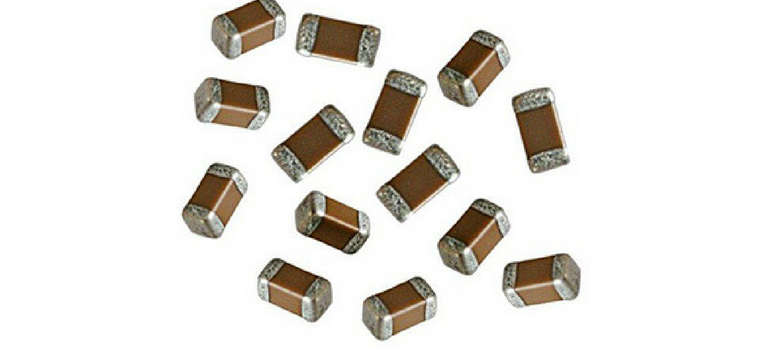
This is Part 2 of a Two Part Series
- Decoupling Part 1:The Basics
- Decoupling Part 2:Low Inductance MLCCs
In my last post we discussed some decoupling basics, including multilayer ceramic capacitors (MLCCs) for tier 1 (high speed) decoupling. In this post we discuss MLCC options for low inductance (ESL). I hope that you find it useful as it is a fascinating subject to me, but first, some history.
History of MLCCs for High Speed Decoupling
Prior to the 1980s almost all electronics used plated through hole technology (PTH). All MLCCs used were of leaded configuration and ESL values were quite high (typically >2,000 picoHenry (pH)). As microprocessor technology advanced to higher frequencies and greater complexity, the need for high speed decoupling was recognized. In the 1970s IBM developed their thermal conduction module (TCM) which utilized the ceramic multichip module (MCM), both “blockbuster” technologies at the time. The technology was highly advanced, including high speed microprocessor technology and multiple other advanced technologies. One highly advanced technology utilized was the use of low inductance “LICA” capacitors as the tier 1 decoupling solution.
Enter the LICA
In conjunction with AVX, IBM invented and developed one of the first designed-for-purpose low inductance MLCCs called the low inductance capacitor array (LICA). This device exhibited world leading performance, having ESL values of 50 (pH) or less. However, LICA was very expensive, and was technically complex, using controlled-collapse-chip-connection (C4) technology, as well as interdigitated terminals for inductance cancellation, as well as enhanced electrode design and geometry for low ESL. Because of its technical complexity, only certain manufacturers could use it and it was not adopted universally. Nevertheless, it was a very impressive product and if you have an IBM mainframe, chances are you have some LICAs.
Enter RGC MLCCs
Even though LICA’s performance was quite impressive, its cost and complexity left an unmet need for a “poor mans’ low inductance capacitor.” The market needed a relatively low cost MLCC that could be easily mounted using standard SMD equipment, materials and techniques. Reverse geometry capacitors (RGCs) are MLCCs having reversed electrode aspect ratio geometry, and that were developed to provide a solution for this need. Example RGCs are pictured above. Using RGC MLCCs resulted in an ESL reduction of about 60% or more compared to analogous standard configuration MLCCs. Relatively low in cost and requiring only minor circuit design modification, RGC MLCCs represented an excellent low cost, low ESL solution, and RGCs are still popular today for some applications.
Enter the IDC
Later, AVX further fleshed-out its low inductance MLCC offering by inventing the interdigitated capacitor (IDC) which exhibited ESL values between that of RGC MLCCs and LICAs. IDC required an intermediately complex mounting scheme (interdigitated mounting pads and complex via schemes, etc.), and was significantly more expensive than standard configuration MLCCs. Even though it was complex and somewhat expensive, IDCs also enjoyed great success as they presented a solution with performance nearing LICA that did not require exotic surface mounting technology (C4 and the like). Many millions of computer microprocessors were decoupled using IDCs, and IDCs are still popular for certain applications today.
Enter the KISS Principle
The low ESL market was still not satisfied by the above solutions however, and microprocessor manufacturers and their circuit designers kept looking for low ESL solutions that are simple and cheap. Over the above time period, and as MLCC miniaturization efforts began, it came to the realization of designers that ESL values of large case size, standard configuration MLCCs are significantly higher than the ESL values exhibited by their smaller case “brethren.” Using this knowledge, designers started designing with standard configuration MLCCs, using the smallest case size where acceptable capacitance values were generally available “on the cheap” (see A Farad on the Head of Pin for Free for details).
Since EIA 0402 and EIA 0201 standard configuration MLCCs exhibit ESLs that are on the order of 0612 IDCs, and since Class 2 dielectric versions are generally available in these case sizes with capacitance values as high as 10 µF and 1 µF for 0402 and 0201 sizes respectively, many designers have pursued the strategy of using standard small case MLCCs. A further advantage of this approach is that it allows relatively simple, standard circuit designs. This is also advantageous as small case standard configuration MLCCs are now generally available and are priced most competitively compared to other low ESL solutions. Because of these advantages, this approach is now the generally accepted solution for high speed decoupling and is used in many, if not most, high speed decoupling applications today.
Enter “Other” Solutions
Over this time frame, other low ESL MLCC configurations have been realized as well, such as controlled ESR IDCs, interposer MLCCs and the like. These solutions have also suffered from cost and complexity however, and the simple, low cost solution of using numerous small case, standard configuration MLCCs, combined with prudent circuit design (as discussed in Part 1 of this series) has become the prominent solution, with other configurations, such as RGC MLCC, generally being used in specialized designs that cannot utilize very small case size components.
Closing Thoughts
Although, as stated in Part 1 of this series, ESL is more important than capacitance for decoupling at high frequencies, it is still important to understand and compensate for the fact that the capacitance of Class 2 dielectric MLCCs may drop significantly when a DC voltage is applied (even with voltages as low as those used to power modern microprocessors). An understanding of this phenomenon is provided in Venkel’s technical paper, “Testing and Measurement Practices of High Capacitance Ceramic Capacitors,” and is defined for MLCCs of interest in Venkel’s “Electrical Characteristics Data (ECD) for Ceramic Capacitors.” Well, that’s it for MLCCs for high speed decoupling. My next post will cover ESR…TTFN!







